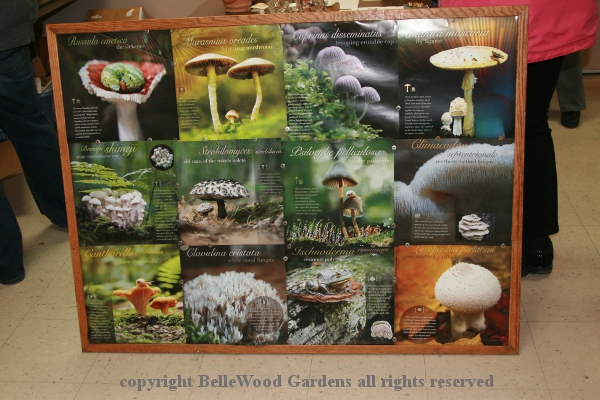
.
If you have any comments, observations, or questions about what you read here, remember you can always Contact Me
All content included on this site such as text, graphics and images is protected by U.S and international copyright law.
The compilation of all content on this site is the exclusive property of the site copyright holder.
Wednesday, 24 January 2018
Fourth Wednesday of the month, which means it is Tohickon garden club meeting this morning. Today's multi-focused program is a brunch (prepared by the club's hostesses), the annual clear-out-your-cupboards white elephant sale, and a lecture by club member Marion Kyde about mushrooms. There's a mini-design option: bring a mushroom sculpture or replica, and your favorite mushroom recipe. I'm a pot hunter, enjoy foraging for fabulously delicious fungi, and cooking with them. Should be another excellent meeting.

There's a nice poster board depicting a dozen different fungi.
Set on the floor it doesn't seem to get the attention it should.
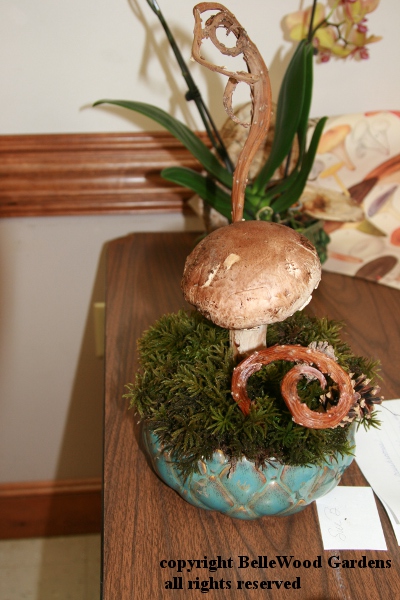
Here's a mini-design by one of our gifted floral arrangers,
incorporating an actual mushroom - a sizable portobello.
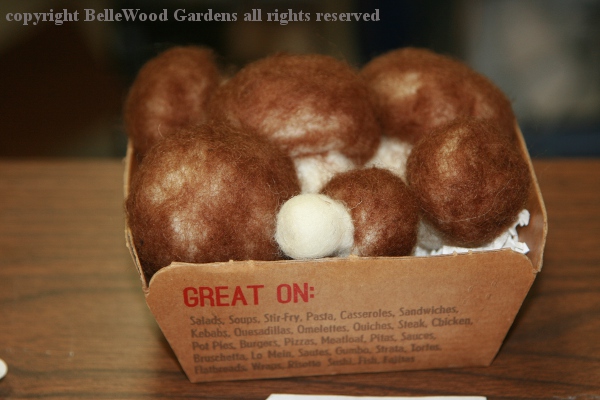
A mushroom box filled with replicas of little brown mushrooms.
Cleverly made of wool roving and felted by another member.
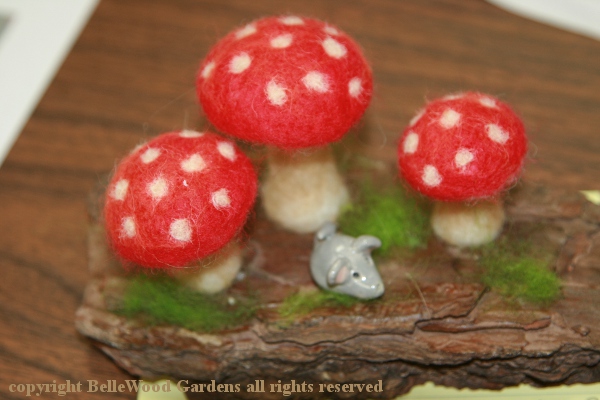
More felted mushrooms,different creator. These Amanita
are the European fairy tale kind (ours are more orange-ish.)
Embellished with a little mouse. I'll get back to that later.
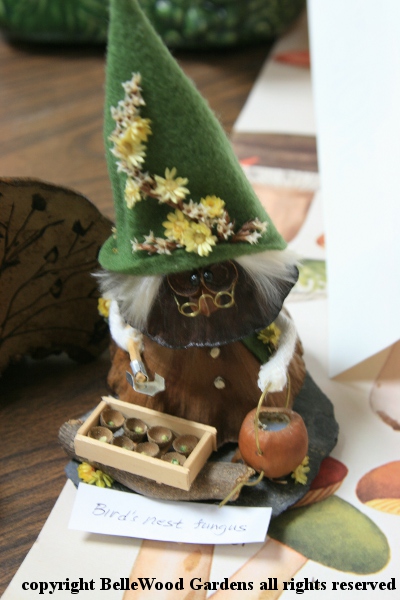
Perhaps you like this bespectacled gnome, with
an acorn bucket and a box of bird's nest fungi.

My darling daughter mentioned a Pinterest page to me,
of crafty glass mushrooms. Aha! A beer glass, upside down,
with an inverted bowl on top. A see-through fungal replica.

I brought along two of my favorite mushroom cookbooks
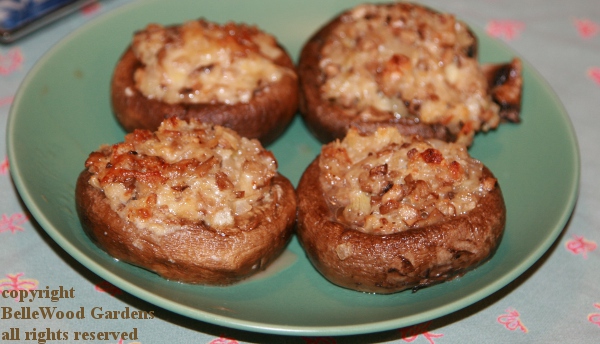
and two recent mushroom-y recipes I made late last December -
stuffed mushroom caps and crepes with a venison duxelle filling.

You can see more about these dishes here
Other recipes provided by members include mushroom tartlets, mushroom phyllo bundles, and zhulein, which is a Russian mushroom casserole from Saveur magazine. And more. They'll be parcelled out in our newsletter, issue by issue rather than all at once.
Fun stuff, but the keynote of the morning is Martie Kyde's fascinating lecture with an excellent introduction to the morphology, ecology, and world wide web connections that fungi have.

What good are mushrooms? Trees, other than water dwellers such as cypress, have mycorrhizal partnerships. Both tree and fungi benefit with a nutrient exchange through the formation of mycorrhizae, which are combinations of both plant and fungal tissue together as one entity in and on the roots of plants. The ectorrhizal fungi grow on the exterior of roots while the endorrhizal fungi cohabit inside the root. Both types of mycorrhizae provide both nitrogen and phosphorus as well as other minerals and water (water most important) - the proportions are different, that's all.The mushrooms help providing water and nutrients to the tree, the tree makes sugars and gives nutrients to the fungi. The fungi cleverly make a 3-part sugar which the tree cannot in turn take back. Anastamosis is what fungal hyphae do as they grow - the threads join together and unjoin as they ramify through the soil.
Recent research into different aspects of what we know about fungi explores their medicinal and other attributes. The death cap mushroom, Amanita phalloides, which has been found in New Jersey, contains multiple toxins of which some may be useful medicinals. The largest, oldest organism in the world is an Armillaria, a honey fungus covering 2,200 acres, multiple tons of the tread-like mycellia and fruiting bodies, going back to the time when the Roman empire was falling apart. Alas, this honey mushroom is pathenogenic, eventually killing the host trees while spreading out to new ones.
Consider this: there are truffles that grow in the old growth forests of the Pacific Northwest. They may not be as flavorful as the truffles of France and Italy. But they are indisputably truffles.
 .
. 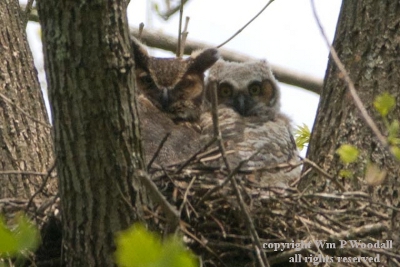
Flying squirrels love to eat truffles. And spotted owls love to eat flying squirrels. [These happen to be a great horned owl and her owlet, but they are what I have to photograph around here.] So the squirrels consume truffles, the owls consume squirrels. What does the truffle get out of this? Both squirrels and owls excrete spores, "planting" more truffles. Interconnections of the web of life.
Big bluestem, Andropogon gerardii, and Indian grass, Sorgastrum nutans have roots that go down 10 feet in the deep, rich soils of the great grasslands of the Midwest. The fungi that partner with them sequester carbon. Remember that mycelium threads are so fine that they can penetrate soil pore spaces that tree roots are too coarse to fit into.
I have said, on many occasions, that I'm a pot hunter. I forage for the half dozen or so deliciously edible mushrooms I find growing near here. After this presentation I may just have changed my mind. It has really given me a fresh look at the intricate world of mushrooms, one that goes beyond the kitchen.
Martie concluded her lecture with this charming poem she learned as a child:
The Elf and the Dormouse
by Oliver Herford. 1863 - 1935
UNDER a toadstool crept a wee Elf,
Out of the rain to shelter himself.
Under the toadstool, sound asleep,
Sat a big Dormouse all in a heap.
Trembled the wee Elf, frightened and yet
Fearing to fly away lest he get wet.
To the next shelter maybe a mile!
Sudden the wee Elf smiled a wee smile.
Tugged till the toadstool toppled in two.
Holding it over him, gaily he flew.
Soon he was safe home, dry as could be.
Soon woke the Dormouse"Good gracious me!
"Where is my toadstool?" loud he lamented.
And that's how umbrellas first were invented.
Back to Top
Back to January 2018
Back to the main Diary Page